Optoelectronic Performance Variations in InGaN/GaN Multiple-Quantum-Well Light-Emitting Diodes: Effects of Potential Fluctuation
Abstract
1. Introduction
2. Samples and Experiments
3. Results and Discussion
3.1. Experimental Results from the LED Samples
3.2. Effects of Local Potential Fluctuation
4. Conclusions
Author Contributions
Acknowledgments
Conflicts of Interest
References
- Razeghi, M.; Rogalski, A. Semiconductor ultraviolet detectors. J. Appl. Phys. 1996, 79, 7433–7473. [Google Scholar] [CrossRef]
- Yang, W.; Nohava, T.; Krishnankutty, S.; Torreano, R.; McPherson, S.; Marsh, H. Back-illuminated GaN/ALGaN heterojunction photodiodes with high quantum efficiency and low noise. Appl. Phys. Lett. 1998, 73, 1086–1088. [Google Scholar] [CrossRef]
- Nakamura, S. The roles of structural imperfections in InGaN-based blue light-emitting diodes and laser diodes. Science 1998, 281, 956–961. [Google Scholar] [CrossRef]
- Chichibu, S.F.; Uedono, A.; Onuma, T.; Haskell, B.A.; Charaborty, A.; Koyama, T.; Fini, P.T.; Keller, S.; Debaars, S.P.; Speck, J.S.; et al. Origin of defect-insentitive emission probability in In-containing (Al,In,Ga)N alloy semiconductors. Nat. Mater. 2006, 5, 810–816. [Google Scholar] [CrossRef] [PubMed]
- Riley, J.R.; Detchprohm, T.; Wetzel, C.; Lauhon, L.J. On the reliable analysis of indium mole fraction within InxGa1−xN quantum wells using atom probe tomography. Appl. Phys. Lett. 2014, 104, 152102. [Google Scholar] [CrossRef]
- Shivaraman, R.; Kawaguchi, Y.; Tanaka, S.; Denbaars, S.; Nakamura, S.; Speck, J.S. Comparative analysis of 2021 and 2021 semipolar GaN light emitting diodes using atom probe tomography. Appl. Phys. Lett. 2013, 102, 251104. [Google Scholar] [CrossRef]
- Bennett, S.E.; Saxey, D.W.; Kappers, M.J.; Barnard, J.S.; Humphreys, C.J.; Smith, G.D.; Oliver, R.A. Atom probe tomography assessment of the impact of electron beam exposure on InxGa1−xN/GaN quantum wells. Appl. Phys. Lett. 2011, 99, 021906. [Google Scholar] [CrossRef]
- Wu, Y.-R.; Shivaraman, R.; Wang, K.-C.; Speck, J.S. Analyzing the physical properties of InGaN multiple quantum well light emitting diodes from nano scale structure. Appl. Phys. Lett. 2012, 101, 083505. [Google Scholar]
- Yang, T.-J.; Shivaraman, R.; Speck, J.S.; Wu, Y.-R. The influence of random indium alloy fluctuations in indium gallium nitride quantum wells on the device behavior. J. Appl. Phys. 2014, 116, 113104. [Google Scholar] [CrossRef]
- Schulz, S.; Caro, M.A.; Coughlan, C.; O’Reilly, E.P. Atomistic analysis of the impact of alloy and well-width fluctuations on the electronic and optical properties of InGaN/GaN quantum wells. Phys. Rev. B 2015, 91, 035439. [Google Scholar] [CrossRef]
- Galtrey, M.J.; Oliver, R.A.; Kappers, M.J.; Humphreys, C.J.; Clifton, P.H.; Larson, D.; Saxey, D.W.; Cerezo, A. Three-dimensional atom probe analysis of green- and blue-emitting InxGa1−xN/GaN multiple quantum well structures. J. Appl. Phys. 2008, 104, 013524. [Google Scholar] [CrossRef]
- Watson-Parris, D.; Godfrey, M.J.; Dawson, P.; Oliver, R.A.; Galtrey, M.J.; Kappers, M.J.; Humphreys, C.J. Carrier localization mechanisms in InxGa1−xN/GaN quantum wells. Phys. Rev. B 2011, 83, 115321. [Google Scholar] [CrossRef]
- Dhar, S.; Jahn, U.; Brandt, O.; Waltereit, P.; Ploog, K.H. Effect of exciton localization on the quantum efficiency of GaN/InGaN multiple quantum wells. Phys. Status Solidi (A) 2002, 192, 85–90. [Google Scholar] [CrossRef]
- Graham, D.M.; Soltani-Vala, A.; Dawson, P.; Godfrey, M.J.; Smeeton, T.M.; Barnard, J.S.; Kappers, M.J.; Humphreys, C.J.; Thrush, E.J. Optical and microstructural studies of InGaN/GaN single-quantum-well structures. J. Appl. Phys. 2005, 97, 103508. [Google Scholar] [CrossRef]
- Oliver, R.A.; Bennett, S.E.; Zhu, T.; Beesley, D.J.; Kappers, M.J.; Saxey, D.W.; Cerezo, A.; Humphreys, C.J. Microstructural origins of localization in InGaN quantum wells. J. Phys. D 2010, 43, 354003. [Google Scholar] [CrossRef]
- Bellaiche, L.; Mattila, T.; Wang, L.-W.; Wei, S.-H.; Zunger, A. Resonant hole localization and anomalous optical bowing in InGaN alloys. Appl. Phys. Lett. 1999, 74, 1842–1844. [Google Scholar] [CrossRef]
- Gerthsen, D.; Hahn, E.; Neubauer, B.; Rosenauer, A.; Schon, O.; Heuken, M.; Rizzi, A. Composition fluctuations in InGaN analyzed by transmission electron microscopy. Phys. Status Solidi (A) 2000, 177, 145–155. [Google Scholar] [CrossRef]
- Cheng, Y.-C.; Lin, E.-C.; Wu, C.-M.; Yang, C.C.; Yang, J.-R.; Rosenauer, A.; Ma, K.-J.; Shi, S.-C.; Chen, L.C.; Pan, C.-C.; et al. Nanostructures and carrier localization behaviors of green-luminescence InGaN/GaN quantum-well structures of various silicon-doping conditions. Appl. Phys. Lett. 2004, 84, 2506–2508. [Google Scholar] [CrossRef]
- Hader, J.; Moloney, J.V.; Koch, S.W. Density-activated defect recombination as a possible explanation for the efficiency droop in GaN-based diodes. Appl. Phys. Lett. 2010, 96, 221106. [Google Scholar] [CrossRef]
- Kudrawiec, R.; Siekacz, M.; Krysko, M.; Cywinski, G.; Misiewicz, J.; Skierbiszewski, C. Contactless electroreflectance of InGaN layers with indium content ≤36%: The surface band bending, band gap bowing, and Stokes shift issues. J. Appl. Phys. 2009, 106, 113517. [Google Scholar] [CrossRef]
- Ponce, F.A.; Srinivasan, S.; Bell, A.; Geng, L.; Liu, R.; Stevens, M.; Cai, J.; Omiya, H.; Marui, H.; Tanaka, S. Microstructure and electronic properties of InGaN alloys. Phys. Status Solidi B 2003, 240, 273–284. [Google Scholar] [CrossRef]
- Wu, X.H.; Elsas, C.R.; Abare, A.; Mack, M.; Keller, S.; Petroff, P.M.; DenBaars, S.P.; Speck, J.S. Structural origin of V-defects and correlation with localized excitonic centers in InGaN/GaN multiple quantum wells. Appl. Phys. Lett. 1998, 72, 692–694. [Google Scholar] [CrossRef]
- Hangleiter, A.; Hitzel, F.; Netzel, C.; Fuhramann, D.; Rossow, U.; Ade, G.; Hinze, P. Suppression of nonradiative recombination by V-shaped pits in GaInN/GaN quantum wells produces a large increase in the light emission efficiency. Phys. Rev. Lett. 2005, 95, 1274702. [Google Scholar] [CrossRef] [PubMed]
- Jeong, H.; Jeong, H.J.; Oh, H.M.; Hong, C.-H.; Suh, E.-K.; Lerondel, G.; Jeong, M.S. Carrier localization I In-rich InGaN/GaN multiple quantum wells for greenlight-emitting diodes. Sci. Rep. 2015, 5, 9373. [Google Scholar] [CrossRef] [PubMed]
- Pereira, S.; Correia, M.R.; Pereira, E.; Trager-Cowan, C.; Sweeney, F.; O’Donnell, K.P.; Alves, E.; Franco, N.; Sequeira, A.D. Structural and optical properties of InGaN/GaN layers close to the critical layer thickness. Appl. Phys. Lett. 2002, 81, 1207–1209. [Google Scholar] [CrossRef]
- Schubert, E.F. Light-Emitting Diodes, 2nd ed.; Cambridge University Press: New York, NY, USA, 2006. [Google Scholar]
- Han, D.-P.; Zheng, D.-G.; Oh, C.-H.; Kim, H.; Shim, J.-I.; Shin, D.-S.; Kim, K.-S. Nonradiative recombination mechanisms in InGaN/GaN-based light-emitting diodes investigated by temperature-dependent measurements. Appl. Phys. Lett. 2014, 104, 151108. [Google Scholar] [CrossRef]
- Choi, I.-G.; Han, D.-P.; Yun, J.; Kim, K.S.; Shin, D.-S.; Shim, J.-I. Investigation of dominant nonradiative mechanisms as a function of current in InGaN/GaN light-emitting diodes. Appl. Phys. Exp. 2013, 6, 052105. [Google Scholar] [CrossRef]
- Takeuchi, T.; Sota, S.; Katsuragawa, M.; Komori, M.; Takeuchi, H.; Amano, H.; Akasaki, I. Quantum-confined Stark effect due to piezoelectric fields in GaInN strained quantum wells. Jpn. J. Appl. Phys. 1997, 36, L382–L385. [Google Scholar] [CrossRef]
- Bernardini, F.; Fiorentini, V. Nonlinear macroscopic polarization in III-V nitride alloys. Phys. Rev. B 2001, 64, 085207. [Google Scholar] [CrossRef]
- Miller, D.A.B.; Chemla, D.S.; Damen, T.C.; Gossard, A.C.; Wiegmann, W.; Wood, T.H.; Burrus, C.A. Band-edge electroabsorption in quantum well structures: The quantum-confined Stark effect. Phys. Rev. Lett. 1984, 53, 2173–2176. [Google Scholar] [CrossRef]
- Chichibu, S.; Azuhata, T.; Sota, T.; Nakamura, S. Spontaneous emission of localized excitons in InGaN single and multiquantum well structures. Appl. Phys. Lett. 1996, 69, 4188–4190. [Google Scholar] [CrossRef]
- Chichibu, S.F.; Abare, A.C.; Mack, M.P.; Minsky, M.S.; Deguchi, T.; Cohen, D.; Kozodoy, P.; Fleischer, S.B.; Keller, S.; Speck, J.S. Optical properties of InGaN quantum wells. Mater. Sci. Eng. B 1999, 59, 298–306. [Google Scholar] [CrossRef]
- Ryou, J.-H.; Lochner, Z.; Dupuis, R.D. Control of quantum-confined Stark effect in InGaN-based quantum wells. IEEE J. Sel. Top. Quantum Electron. 2009, 15, 1080–1090. [Google Scholar] [CrossRef]
- Cho, J.; Sone, C.; Park, Y.; Yoon, E. Measuring the junction temperature of III-nitride light emitting diodes using electro-luminescence shift. Phys. Status Solidi (A) 2005, 202, 1869–1873. [Google Scholar] [CrossRef]
- Shim, J.-I. Active Region Part B. Internal Quantum Efficiency. In III-Nitride Based Light Emitting Diodes and Applications; Seong, T.-Y., Han, J., Amano, H., Morkoc, H., Eds.; Springer: Dordrecht, The Netherlands, 2013; pp. 153–195. ISBN 978-94-007-5862-9. [Google Scholar]
- Nakamura, S.; Fasol, G. The Blue Laser Diode: GaN Based Light Emitters and Lasers; Springer: Berlin/Heidelberg, Germany, 1997; pp. 1–335. ISBN 978-3-662-03464-4. [Google Scholar]
- Bernardini, F.; Fiorentini, V.; Vanderbilt, D. Spontaneous polarization and piezoelectric constants of III-V nitrides. Phys. Rev. B 1997, 56, R10024–R10027. [Google Scholar] [CrossRef]
- Park, S.-I.; Lee, J.-I.; Jang, D.-H.; Kim, H.-S.; Shin, D.-S.; Ryu, H.-Y.; Shim, J.-I. Measurement of internal electric field in GaN-based light-emitting diodes. IEEE J. Quantum Electron. 2012, 48, 500–506. [Google Scholar] [CrossRef]
- Islam, A.B.M.H.; Shin, D.-S.; Shim, J.-I. Interactive study of electroreflectance and photocurrent spectra in InGaN/GaN-based blue LEDs. IEEE J. Quantum Electron. 2017, 53, 3300206. [Google Scholar] [CrossRef]
- Krispin, P.; Spruytte, S.G.; Harris, J.S.; Ploog, K.H. Electrical depth profile of p-type GaAs/Ga(As, N)/GaAs heterostuctures determined by capacitance-voltage measurements. J. Appl. Phys. 2000, 88, 4153–4158. [Google Scholar] [CrossRef]
- Chang, S.J.; Kuo, C.H.; Su, Y.K.; Wu, L.W.; Sheu, J.K.; Wen, T.C.; Lai, W.C.; Chen, J.F.; Tsai, J.M. 400-nm InGaN-GaN and InGaN-AlGaN multiquantum well light-emitting diodes. IEEE J. Sel. Top. Quantum Electron. 2002, 8, 744–748. [Google Scholar] [CrossRef]
- Shim, J.-I.; Han, D.-P.; Oh, C.-H.; Jung, H.; Shin, D.-S. Measuring the internal quantum efficiency of light-emitting diodes at an arbitrary temperature. IEEE J. Quantum Electron. 2018, 54, 8000106. [Google Scholar] [CrossRef]
- Kim, M.-H.; Lee, W.; Zhu, D.; Schubert, M.F.; Kim, J.K.; Schubert, E.F.; Park, Y. Partial polarization matching in GaInN-based multiple quantum well blue LEDs using ternary GaInN barriers for reduced efficiency droop. IEEE J. Sel. Top. Quantum Electron. 2009, 15, 1122–1127. [Google Scholar] [CrossRef]
- Zhu, D.; Xu, J.; Noemaun, A.N.; Kim, J.K.; Schubert, E.F.; Crawford, M.H.; Koleske, D.D. The origin of the high diode-ideality factors in GaInN/GaN multiple quantum well light-emitting diodes. Appl. Phys. Lett. 2009, 94, 081113. [Google Scholar] [CrossRef]
- Lee, G.W.; Shim, J.-I.; Shin, D.-S. On the ideality factor of the radiative recombination current in semiconductor light-emitting diodes. Appl. Phys. Lett. 2016, 109, 031104. [Google Scholar] [CrossRef]
- Han, D.-P.; Oh, C.-H.; Zheng, D.-G.; Kim, H.; Shim, J.-I.; Kim, K.-S.; Shin, D.-S. Analysis of nonradiative recombination mechanisms and their impacts on the device performance of InGaN/GaN light-emitting diodes. Jpn. J. Appl. Phys. 2014, 54, 02BA01. [Google Scholar] [CrossRef]
- Baş, Y.; Demirel, P.; Akin, N.; Başköse, C.; Özen, Y.; Kinaci, B.; Öztürk, M.K.; Özçelik, S.; Özbay, E. Microstructural defect properties of InGaN/GaN Blue light emitting diode structures. J. Mater. Sci. Mater. Electron. 2014, 25, 3924–3932. [Google Scholar] [CrossRef]
- Lee, S.-N.; Peak, H.S.; Son, J.K.; Kim, H.; Kim, K.K.; Ha, H.K.; Nam, O.H.; Park, Y. Effects of Mg dopant on the degradation of InGaN multiple quantum wells in AlInGaN-based light emitting devices. J. Electroceram. 2008, 23, 406–409. [Google Scholar] [CrossRef]
- Van de Walle, C.G.; Neugebauer, J. First-principles calculations for defects and impurities: Applications to III-nitrides. J. Appl. Phys. 2004, 95, 3851–3879. [Google Scholar] [CrossRef]
- Bezyazychnaya, T.V.; Kabanau, D.M.; Kabanov, V.V.; Lebiadok, Y.V.; Ryabtsev, A.G.; Ryabtsev, G.I.; Zelenkovskii, V.M.; Mehta, S.K. Influence of vacancies on indium atom distribution in InGaAs and InGaN compounds. Lith. J. Phys. 2015, 55, 10–16. [Google Scholar] [CrossRef][Green Version]
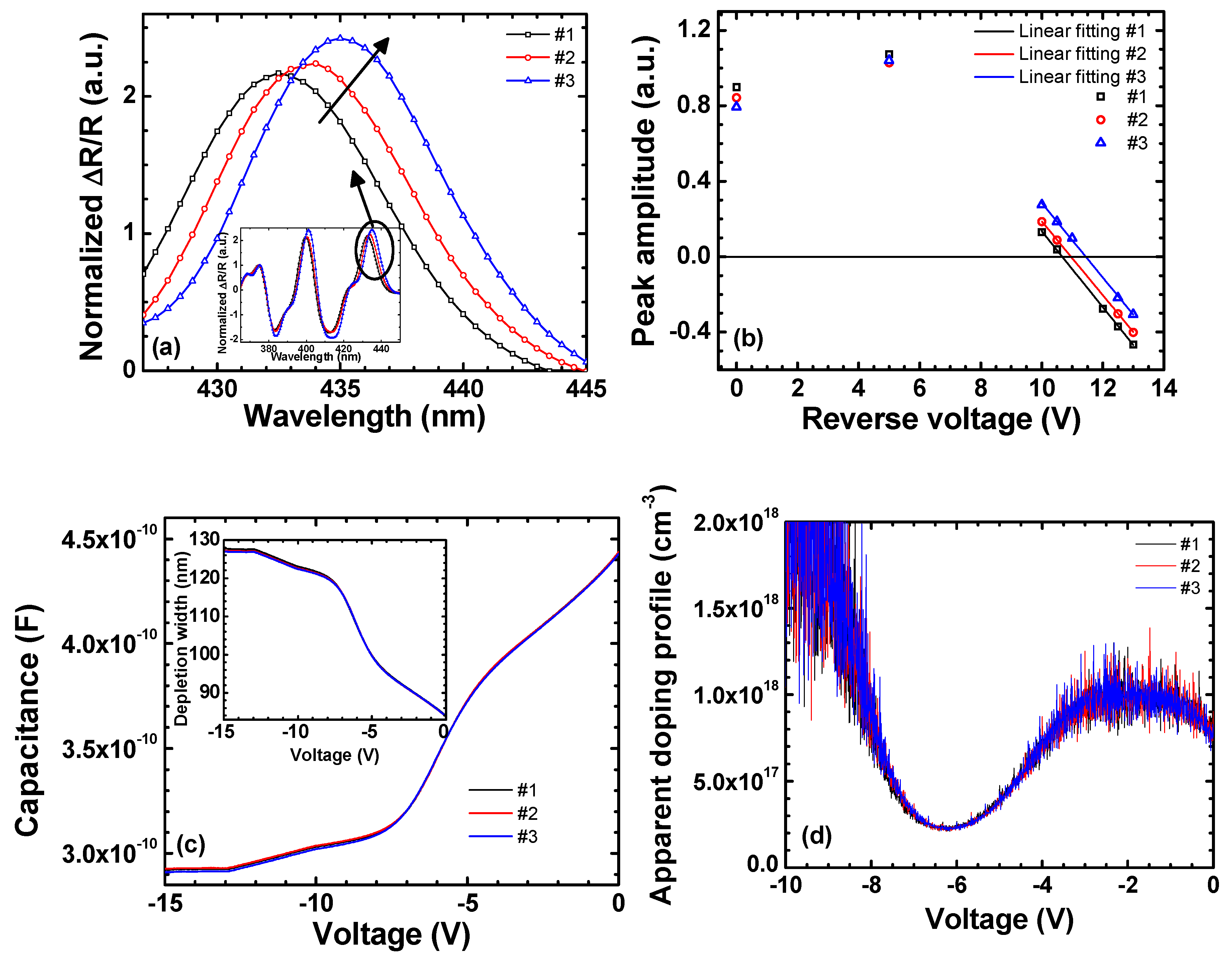
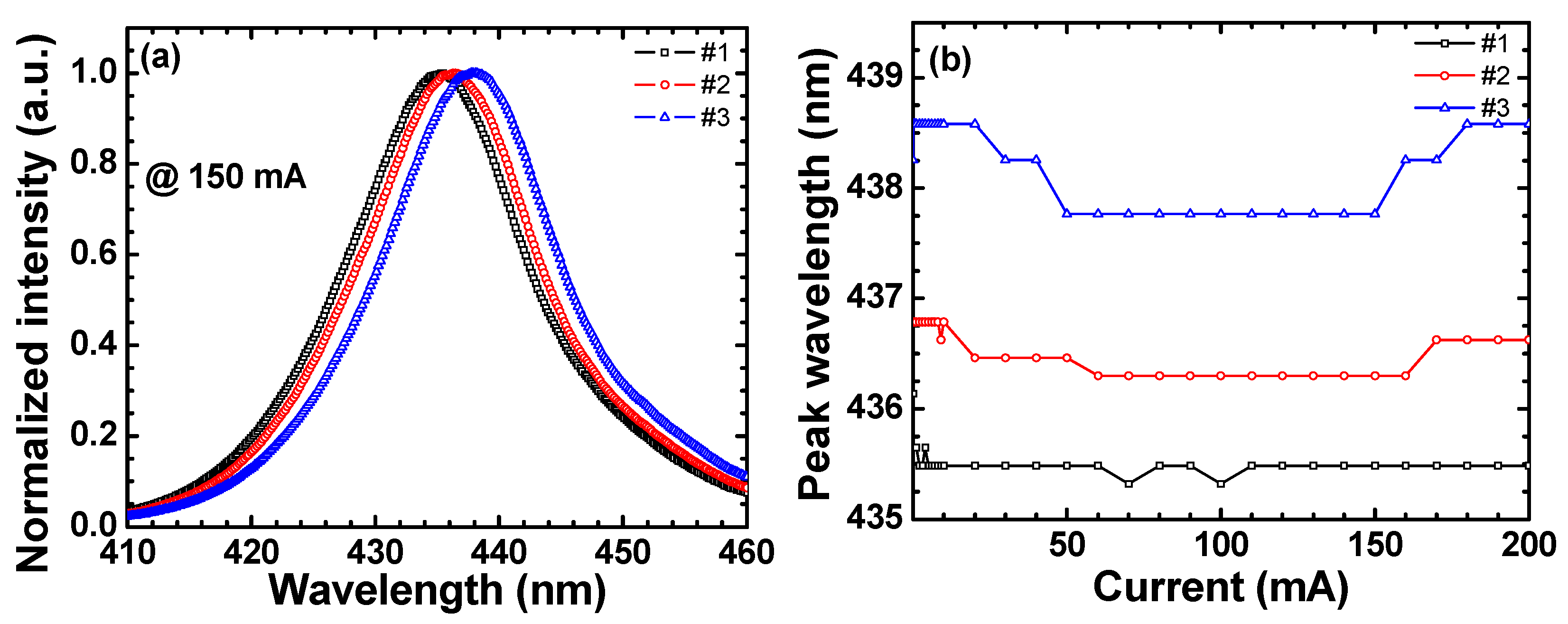
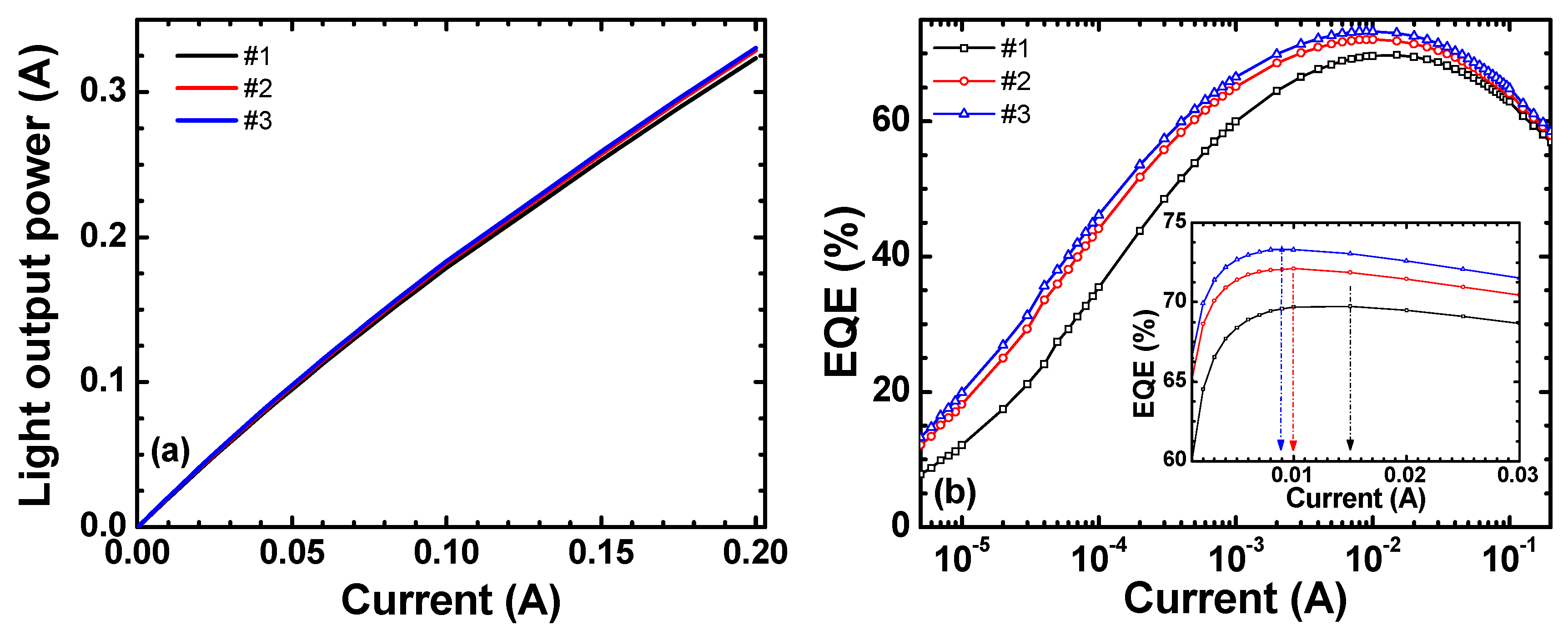
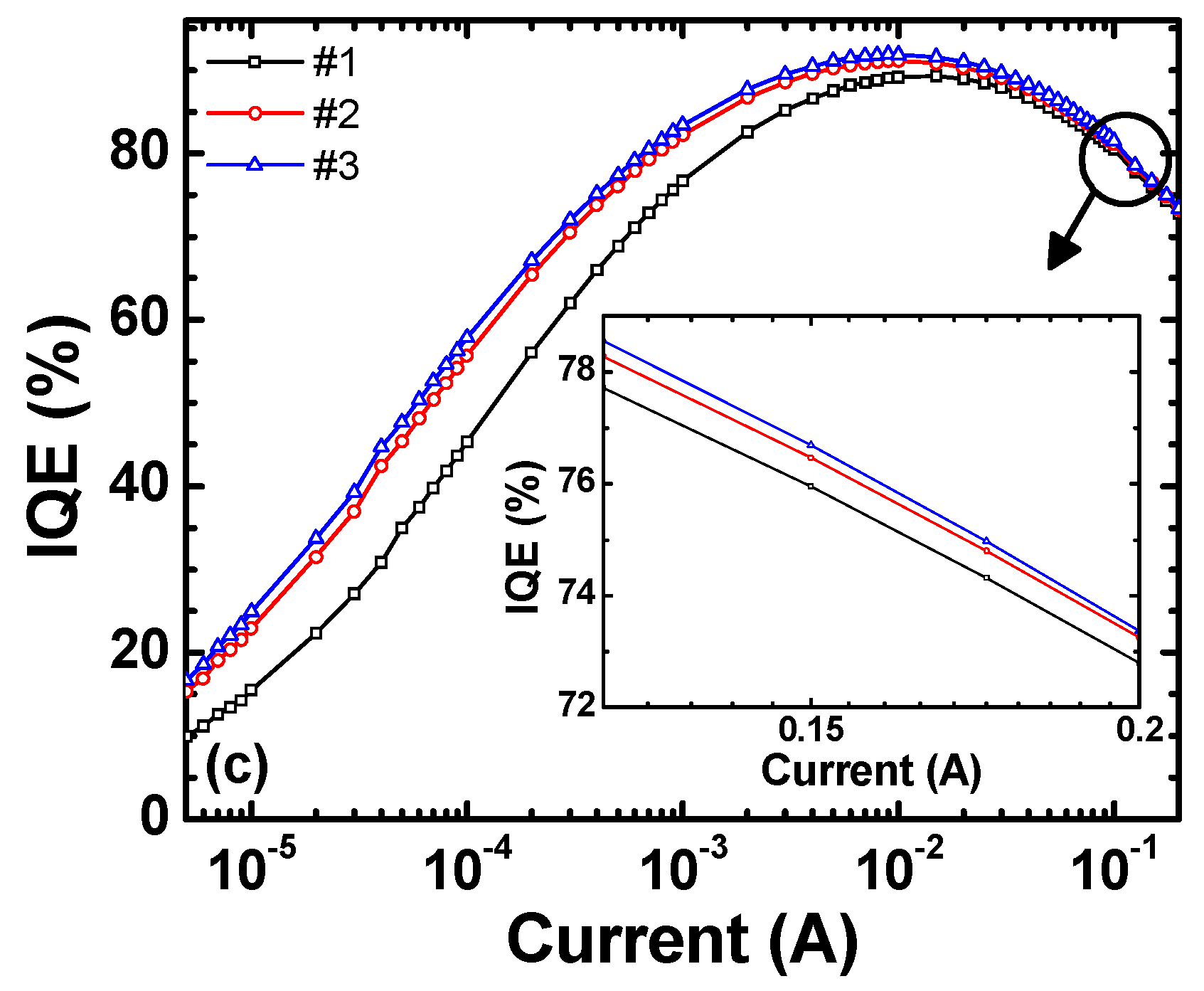
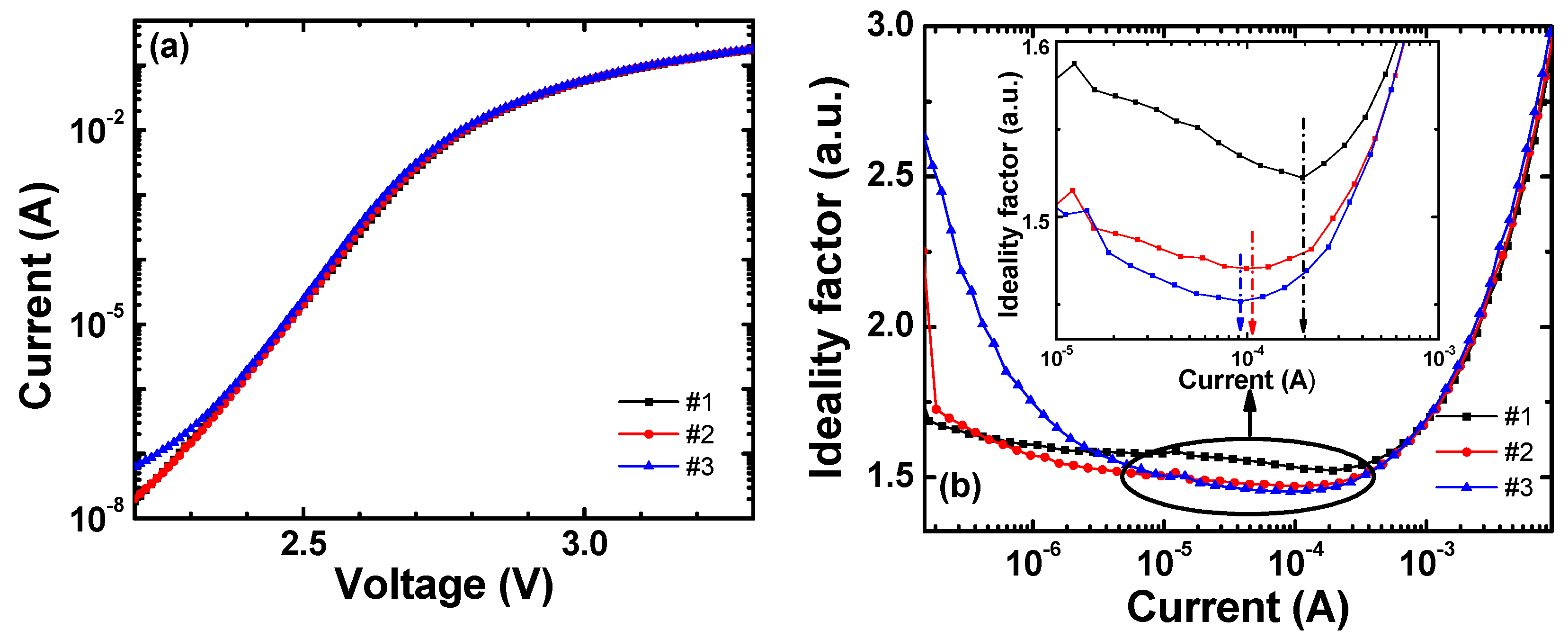

(%) | (mA) | (%) | (a.u.) | (mA) | (V) | (MV/cm) | (nm) | |
|---|---|---|---|---|---|---|---|---|
| #1 | 89.0 | 15.0 | 15.0 | 1.52 | 0.20 | −10.5 | −1.35 | 435.5 |
| #2 | 91.5 | 10.0 | 16.0 | 1.47 | 0.10 | −10.9 | −1.40 | 436.5 |
| #3 | 92.0 | 9.0 | 16.6 | 1.45 | 0.09 | −11.5 | −1.50 | 438.0 |
© 2018 by the authors. Licensee MDPI, Basel, Switzerland. This article is an open access article distributed under the terms and conditions of the Creative Commons Attribution (CC BY) license (http://creativecommons.org/licenses/by/4.0/).
Share and Cite
Islam, A.B.M.H.; Shim, J.-I.; Shin, D.-S. Optoelectronic Performance Variations in InGaN/GaN Multiple-Quantum-Well Light-Emitting Diodes: Effects of Potential Fluctuation. Materials 2018, 11, 743. https://doi.org/10.3390/ma11050743
Islam ABMH, Shim J-I, Shin D-S. Optoelectronic Performance Variations in InGaN/GaN Multiple-Quantum-Well Light-Emitting Diodes: Effects of Potential Fluctuation. Materials. 2018; 11(5):743. https://doi.org/10.3390/ma11050743
Chicago/Turabian StyleIslam, Abu Bashar Mohammad Hamidul, Jong-In Shim, and Dong-Soo Shin. 2018. "Optoelectronic Performance Variations in InGaN/GaN Multiple-Quantum-Well Light-Emitting Diodes: Effects of Potential Fluctuation" Materials 11, no. 5: 743. https://doi.org/10.3390/ma11050743
APA StyleIslam, A. B. M. H., Shim, J.-I., & Shin, D.-S. (2018). Optoelectronic Performance Variations in InGaN/GaN Multiple-Quantum-Well Light-Emitting Diodes: Effects of Potential Fluctuation. Materials, 11(5), 743. https://doi.org/10.3390/ma11050743







